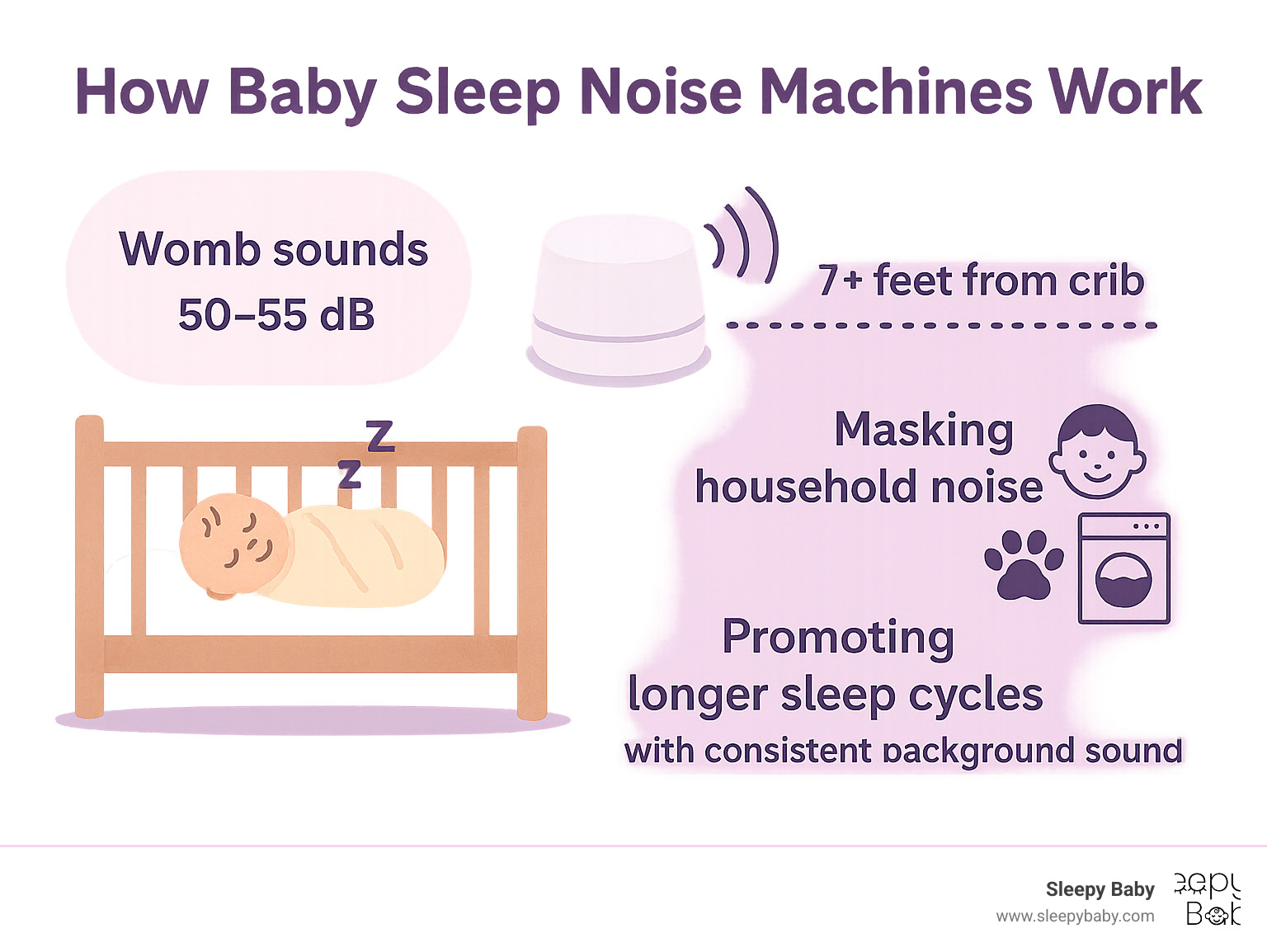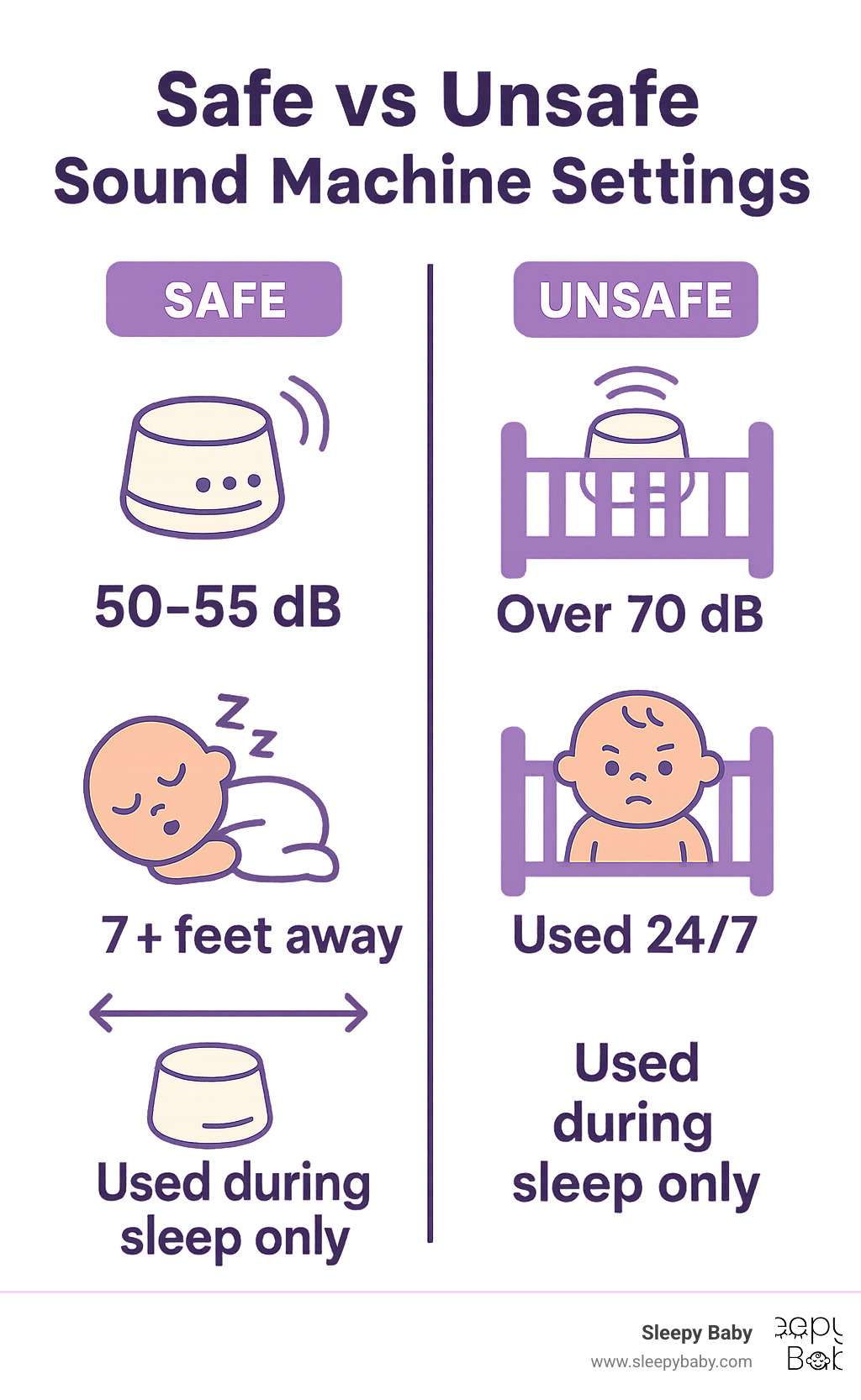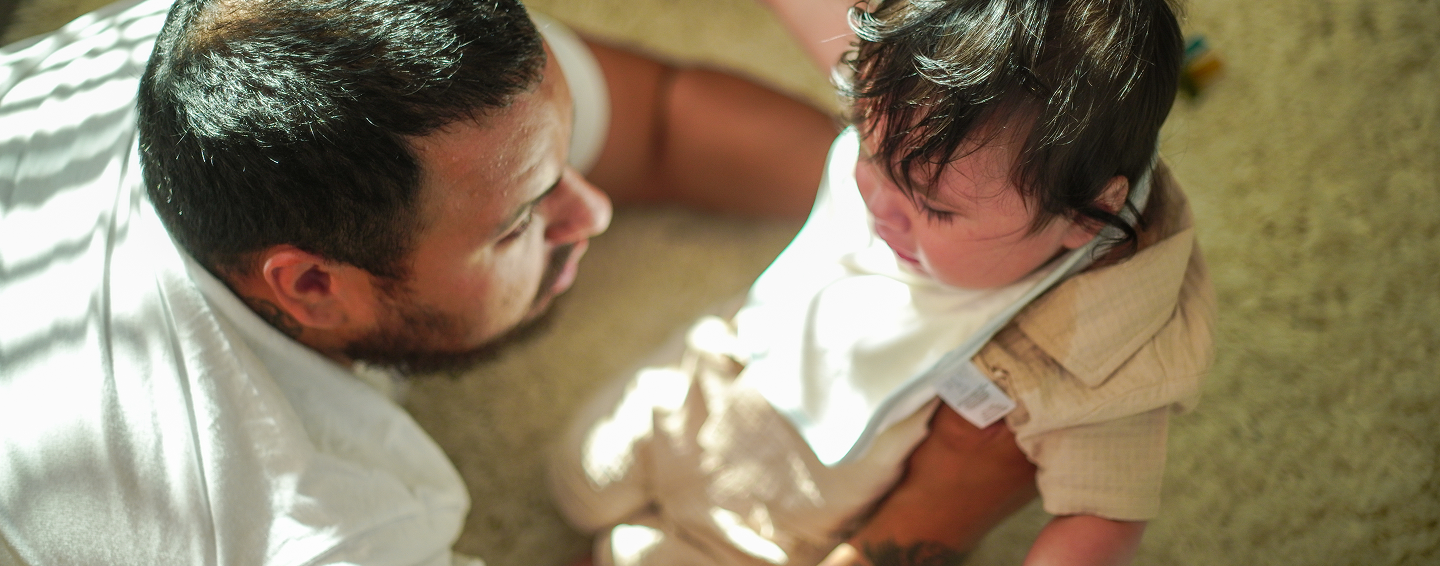Why a Baby Sleep Noise Machine Can Transform Your Family's Sleep
A baby sleep noise machine provides consistent, soothing sounds that help infants fall asleep faster and stay asleep longer by masking household noise and mimicking the familiar sounds of the womb.
Key Benefits of Baby Sleep Noise Machines: - Faster Sleep Onset - Babies fall asleep 23% faster with consistent white noise - Longer Sleep Duration - Reduces night wakings by masking sudden sounds - Calms Fussy Babies - Mimics womb sounds that provided comfort for 9 months - Safe When Used Properly - Keep volume at 50-55 dB and place 7+ feet from baby - Portable Consistency - Maintains familiar sleep environment during travel
If you're a sleep-deprived parent dealing with frequent night wakings, you're not alone. Research shows that up to 67% of adults report sleep disturbances nightly, and new parents face even greater challenges.
The science is clear: babies spent nine months in a noisy womb environment filled with rushing blood, heartbeats, and digestive sounds. Complete silence can actually feel uncomfortable to newborns who are used to constant background noise.
However, safety matters. The American Academy of Pediatrics recommends keeping sound machines at 50-55 dB and placing them at least 7 feet from your baby's sleeping area.
I'm Gary Harutyunyan, and as a new father who struggled with my own baby's sleep challenges, I understand the desperation of sleepless nights. My experience developing the Sleepy Baby patting device taught me that the right baby sleep noise machine can be a game-changer for exhausted families.

Baby Sleep Noise Machine 101
A baby sleep noise machine is your secret weapon against those 3 AM wake-ups. These devices work by creating a consistent blanket of sound that masks random noises - the garbage truck at dawn, your neighbor's dog, or that creaky floorboard.
Continuous sounds work differently than looped sounds. Continuous sounds are generated in real-time, like a fan's hum. Looped sounds are recordings that repeat every few minutes. Many babies notice when a loop restarts, causing brief wake-ups.
The magic happens because these machines mimic the womb environment your baby knew for nine months. Inside the womb wasn't quiet - there were constant sounds from heartbeat, blood flow, and digestive noises. Complete silence can feel strange to a newborn.
What is a baby sleep noise machine?
A baby sleep noise machine produces steady background sounds designed to help your little one sleep better. White noise contains all frequencies equally - that classic "shushing" sound. Pink noise emphasizes lower frequencies, sounding like gentle rain. Brown noise goes deeper with more bass, resembling ocean waves.
Mechanical sound machines use actual fans or motors to create natural white noise, while digital versions play recorded sounds through speakers. Mechanical machines produce more authentic, non-repetitive sound, though digital ones offer more variety.
How does a baby sleep noise machine support infant sleep?
These devices provide sensory comfort by recreating familiar womb sounds. Startle reflex reduction is another benefit - sudden sounds like doors closing can trigger the startle reflex and wake a sleeping baby. Consistent background noise acts like a sound shield.
Most importantly, babies using noise machines tend to have longer sleep cycles. The consistent sound helps them transition between sleep phases without fully waking.
Scientific research on womb noise benefits supports what many parents have found - recreating womb-like conditions significantly improves infant sleep quality and duration.
Benefits and Potential Downsides
When used correctly, baby sleep noise machines offer tremendous benefits with minimal risks. Most concerns are either unfounded or easily prevented with proper use.
Key benefits of using a baby sleep noise machine
Instant calm for overwhelmed newborns is often the first benefit parents notice. That consistent whooshing sound can stop crying faster than you'd believe possible.
Longer, more predictable naps become the norm. Instead of frustrating 20-minute catnaps, many babies start sleeping for solid hour-plus stretches.
Travel becomes manageable when you can pack familiar sounds. Hotel rooms, grandparents' houses, even the car - your baby's sleep environment travels with you.
Your own sleep improves dramatically when baby isn't waking at every household sound. The dishwasher, older siblings playing, even your partner's snoring won't disturb a baby sleeping with proper sound masking.
Possible risks & how to mitigate them
Hearing damage is the only real concern backed by science. Some machines can produce dangerous sound levels - but only when cranked to maximum volume or placed directly next to baby's head. The scientific research on safe decibel levels found problems only with improper usage.
The fix is straightforward: keep your machine at conversational volume (50-55 decibels) and place it across the room.
Speech development fears are largely myth. Your baby isn't listening during awake time when language learning happens. They're getting plenty of quiet time to hear your voice and environmental sounds.
The "dependency" worry misses the point. Yes, your baby might sleep better with their sound machine - that's exactly what you want! This isn't addiction; it's a healthy sleep association.
Safety Checklist: Volume, Placement & Duration
When it comes to your baby's safety, there's no room for guesswork with a baby sleep noise machine. The American Academy of Pediatrics provides clear recommendations.
The magic numbers are 50-55 dB at a distance of at least 7 feet from your baby's sleeping area. This sounds about as loud as a running shower or quiet conversation in the next room.
Duration is simple: use your sound machine throughout sleep periods, but avoid having it running constantly during awake time - your baby needs quiet moments to hear your voice and develop healthy auditory processing.

Can a baby sleep noise machine be too loud?
Yes, a baby sleep noise machine can absolutely be too loud. When you're desperate for sleep at 3 AM, the temptation is to crank up the volume. But louder isn't better.
The safe zone is 50-55 dB measured at your baby's ear level. The CDC recommends staying under 60 dB for infant exposure.
Here's my favorite volume test: if your baby sleep noise machine sounds like a running shower, you're in the perfect range. If it's as loud as a vacuum cleaner, it's too loud.
The scientific research on sound level meters shows that smartphone apps can give you surprisingly accurate decibel readings. Download a free decibel meter app and place your phone where your baby's head rests in the crib to check that readings stay between 50-55 dB.
Where to place your baby sleep noise machine
The golden rule: place the machine as far from your baby as possible while still getting good sound coverage. The American Academy of Pediatrics recommends at least 7 feet away.
Position the machine between the source of disruptive noise and your baby's crib. If the nursery shares a wall with your kitchen, place the machine near that wall rather than near the crib.
Some families find that using two machines works better than one loud machine. Place one outside the nursery door and one inside the room for layered sound protection without high volumes.
How to Choose the Best Baby Sleep Noise Machine
Shopping for a baby sleep noise machine doesn't have to be overwhelming. Focus on features that truly matter for your baby's safety and sleep success.
Sound variety is most important. Every baby is different - some love white noise, others prefer pink or brown noise. Having options means you can experiment to find what works.
Volume control is critical. Look for machines with precise adjustments so you can hit that 50-55 decibel sweet spot.
Timer settings help if you prefer not to run the machine all night. Portability is a game-changer for busy families - lightweight, cordless machines maintain sleep routines anywhere.
A child lock prevents curious toddlers from accidentally changing settings at 3 AM.
For comprehensive guidance on choosing sleep aids, our Dreamland Awaits guide covers various infant sleep solutions.
Features that set a baby sleep noise machine apart
Multiple sound options top the must-have list. While white noise gets attention, many babies prefer pink noise or brown noise.
Precise volume control separates good machines from great ones. Fine-tuned adjustments help you find the perfect volume.
Rechargeable batteries offer incredible flexibility. You can place the machine exactly where it works best without worrying about outlets.
Quality sound generation makes the biggest difference between budget and premium machines. Better machines produce cleaner, more consistent sound without hissing or crackling.
Age guidelines & when to stop using a baby sleep noise machine
There's no expiration date on using a baby sleep noise machine. Many families continue using them for years.
During the newborn stage (0-3 months), sound machines often feel like a lifesaver. The infant months (3-12 months) show the most dramatic benefits as sleep patterns mature.
Toddlers often still benefit from sound machines, especially during nap time. Some families naturally phase out the machine as their child gets older, while others continue indefinitely. Both approaches are fine.
If you want to gradually reduce dependence, slowly decrease volume over several weeks rather than going cold turkey.
Real-World Tips, Travel Hacks & Alternatives
Using a baby sleep noise machine effectively goes beyond just turning it on at bedtime. Here are practical strategies from real families.
Layering Techniques: Combine your sound machine with swaddling, dim lighting, and consistent bedtime routines. The machine works best as part of a comprehensive sleep strategy.
Travel Success: Bring your portable machine everywhere - day trips, overnight visits, and vacations. The familiar sound helps your baby sleep in unfamiliar environments.

For additional infant sleep strategies, explore our Naturally Restful article covering various soothing techniques.
On-the-go with a baby sleep noise machine
Traveling with a baby sleep noise machine requires planning, but the benefits are worth it.
USB Charging: Choose machines with USB charging so you can power up using phone chargers, car adapters, or portable battery packs.
Clip-On Designs: Machines that attach to strollers or cribs are incredibly convenient for naps on-the-go.
Battery Checklist: Always charge fully before trips and bring backup power for longer journeys.
Non-electronic soothing options to pair with a baby sleep noise machine
Swaddling: Wrapping your baby snugly mimics the womb's confined feeling. Combined with white noise, swaddling can be incredibly effective.
Consistent Bedtime Routine: Establish predictable activities before sleep - diaper change, feeding, swaddling, then turning on the sound machine.
Rhythmic Movement: At Sleepy Baby, we've found that combining gentle rhythmic patting with white noise creates an incredibly soothing environment. Our portable patting device mimics comforting caregiver touch while the sound machine provides auditory comfort.
Frequently Asked Questions about Baby Sleep Noise Machines
As a parent who's been through sleepless nights myself, I know you have questions about using a baby sleep noise machine. Here are the three concerns I hear most often.
Are babies at risk of becoming dependent on a baby sleep noise machine?
What we call "dependency" is really just a positive sleep association - and that's wonderful. Think about your own sleep preferences. Maybe you need darkness or a fan running. These aren't unhealthy dependencies - they're conditions that help you rest well.
Your baby isn't developing addiction to white noise. They're learning this familiar sound means sleep time. This association helps establish healthy sleep patterns.
Babies are remarkably adaptable. If you ever need to stop using the machine, most babies adjust within a few nights. Better sleep means better development and more rest for your family.
How loud should the machine be inside the crib?
The sound level where your baby sleeps should never exceed 50-55 decibels - about as loud as a quiet conversation.
Measure sound level from inside the crib, not from where the machine sits. Download a free decibel meter app and take readings from where your baby's head would be.
Simple test: if you can't have a normal conversation in the nursery when the machine is running, it's too loud.
At what age should I retire our baby sleep noise machine?
There's no expiration date on using a baby sleep noise machine. Many sleep experts recommend continuing as long as they're helpful - well into toddler years or beyond.
If you decide to stop, gradually reduce the volume over several weeks rather than going cold turkey. Trust your instincts and do what works for your family.
Conclusion
A baby sleep noise machine isn't magic, but it can be a powerful ally when used safely and effectively. After nine months of constant womb sounds, complete silence can feel unsettling to newborns.
Safety always comes first. Keep volume at 50-55 dB and place the machine at least 7 feet away. These guidelines ensure benefits without risks to developing hearing.
Baby sleep noise machines work best as part of a complete approach. Combine soothing sounds with consistent bedtime routines, appropriate room temperature, and comfortable swaddling.
At Sleepy Baby, we see this holistic approach daily. While our portable patting device provides gentle, rhythmic touch that mimics a caregiver's hand, many families pair it with white noise machines for the complete womb-like experience.
There's no "perfect" age to stop using a sound machine. Trust your instincts and follow your baby's cues. If everyone is sleeping better, you're doing something right.
For families ready to explore comprehensive sleep strategies, our Ultimate Guide to Baby Sleep Solutions offers practical techniques for peaceful nights.
Sweet dreams to you and your precious little one - you both deserve all the rest you can get!



